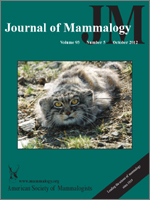We estimated sex- and age-specific apparent survival of harbor seals (Phoca vitulina richardii) born at Tugidak Island, Alaska, from 2000 to 2007 using mark–recapture models and photographs of ventral pelage markings to identify individuals. Estimates of annual apparent survival (1 − (mortality emigration)) of females were from 0.05 to 0.10 higher than those of males and were 0.820 for weaning (∼1 month) to 1 year, 0.865 for 1–3 years, and 0.929 at 3–7 years. Annual survival of males was 0.717, 0.782, and 0.879 for the same ages. Highest mortality occurred preweaning, with cumulative mortality to 4 weeks of age of 0.259, indicating this is the most vulnerable period for Tugidak harbor seals. Estimates of survival, not biased by misidentification, required that an individual had at least 2 good-quality, matching photographs in the photograph library. The number of photographs available for matching improved resighting probabilities from 0.43 for seals with 2 photographs to 0.69 for seals with 8 photographs, but this heterogeneity did not affect survival estimates. Survival estimates based on photograph-identification data were nearly identical to those based on resightings of flipper-tagged seals using mark–recapture models with a preliminary double-tag–loss estimate of 2.5% per year. Photograph identification of natural pelage markings provides a viable method for estimating vital rates of harbor seals even at large haul-outs (>1,000 animals) and may be useful for populations of conservation concern that require low disturbance of animals or where capturing sufficient numbers of seals for artificial marking is not feasible.
How to translate text using browser tools
1 October 2012
Sex- and age-specific survival of harbor seals ( Phoca vitulina) from Tugidak Island, Alaska
Kelly K. Hastings,
Robert J. Small,
Grey W. Pendleton

Journal of Mammalogy
Vol. 93 • No. 5
October 2012
Vol. 93 • No. 5
October 2012
Harbor Seal
mark–recapture
natural markings
Phoca vitulina
photograph identification
survival




